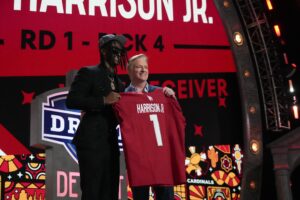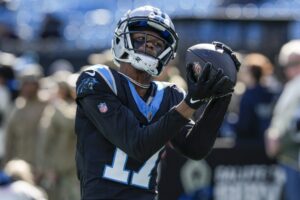Since his arrival in 2011 many fans have been calling for Darrell Bevell to be fired. Pointing to questionable play calls in large games or questioning his ability to adjust week to week and quarter to quarter. After a heart wrenching loss in Superbowl XLIX there has been controversy over whether Bevell is a competent offensive coordinator. This week we’ll look at four crucial down against the Cardinals to determine if fans are right to complain.
Analyzing Darrell Bevell against the Cardinals
Third and twenty three, Seattle 24, First quarter
Formation: Shotgun
Personnel: One running back, one tight end and three wide receivers
Seattle had dug themselves in a 23 yard hole on their first drive of the game. After a Jermaine Kearse offensive pass interference call and a Russell Wilson sack they were looking at third and long. Offensive coordinator Darrell Bevell has a decision to make. Does he call a long developing or a quick play to give his punter a chance to flip field position.
He chooses to “play it safe” and calls a draw play to fullback Marcel Reece. In theory there is little that can go wrong with this play. Reece either picks up a couple yards, gets tackled at the line of scrimmage or somehow picks up a first down. The newly tenured fullback doesnt realize he’s supposed to take the hand off from Wilson, and he fumbles the ball leading to a Cardinals recovery.
The Seahawks line up in the shotgun formation with Jimmy Graham and Reece in the backfield accompanying Wilson. Wide receivers Doug Baldwin, Tyler Lockett and Jermaine Kearse are lined up with two on right and one split out left.The Cardinals are in a nickel package looking to defend a deep pass which provides Reece plenty of room to run the football. Reece, who ran a 4.42 forty yard dash, has an opportunity at 10-15 yards, if not a first down, if he holds on to the ball on this play.

Justin Britt snaps the ball to Wilson who holds on to it for a moment before attempting to hand it off to Reece, who is looking to pass block and doesn’t see the ball until it’s bouncing off of him to the ground. Looking down the right side of the field they had a favorable match up with three blockers and four defenders. This means that Reece would only have to beat one defender in open space. With Graham, Baldwin and Kearse blocking for him and his speed there was yards for the taking.

While the play called is a safe one, the result was disastrous allowing the Cardinals to score first and go up by seven. The fans arguing to fire the offensive coordinator will point to a play like this as proof. However due to the situation with the score tied, being deep in their own territory and not wanting to risk turning the ball over, this appears to be the correct playcall. That becomes even more obvious when looking at the fact that Reece had an opportunity to pick up a large chunk of yardage on the play.
Third and eight, Arizona 18, First quarter
Formation: Shotgun with trips right
Personnel: One running back, one tight end, three receivers
After a 31 yard pass interference call on Cardinals D.J. Swearinger, the Seahawks were in the redzone ready to tie the game at seven. Facing another third and long, albeit not quite as long as before, Bevell called a passing play to pick up the first down.The play consists of Baldwin running a deep dig route, Kearse runs a post route into the endzone while Lockett runs a go route which he sits down looking for a back shoulder fade. Graham runs a crossing route hoping to give Wilson a shorter route with Rawls running an out route to the sideline.

The Seattle offensive line is manhandled on this play. Rookie left tackle George Fant is lined up across from Cardinals Chandler Jones. On this play Graham chips Jones to give Fant help blocking the dominant defensive end. Fant can’t handle Jones even with the help and Jones gets around the edge quickly to get to Wilson. The right side of the line does worse however, with Markus Golden lined up across from Garry Gilliam and a defensive tackle over rookie Germain Ifedi. Golden runs a stunt and engages with Gilliam, releases and then circles around through the open “B” gap. Ifedi tries to pick up Golden but instead hooks him by the neck and could have been called for holding. Britt gives Golden a shove but doesn’t attempt to maintain a block and ends up having no impact on the play. Golden is the second man to Wilson for the sack.


Arizona’s defensive backs plaster to the Seattle receivers, the only player to come open for a moment is Graham but hes bracketed by Cardinals. This eliminates the possibility of Wilson throwing a quick pass to at least give his players a chance to make the first down. Running back Thomas Rawls looks open in the flat but he has his back turned to Wilson up until Wilson is about to get sacked.
Due to the pocket collapsing from all angles Wilson cannot step up in the pocket to avoid a sack or escape out the back because of Jones closing fast from the left side. The only option is to throw it away but Wilson holds it too long and takes the sack back at the 28.

Compared to the previous play this is a much more aggressive attempt to pick up the first down while in the red zone. The play relies on the receivers to create separation, allowing Wilson to get them the ball. None of them could achieve that on this play and the offensive line couldn’t hold off the four man rush to keep the Cardinals at bay.
The play call was designed to pick up the first down. It was apparent up to this point in the game that the offensive line couldn’t protect their quarterback. Since the Seahawks needed eight yards on this play it could be argued that a play incorporating quick passing concepts such as slants and 10 yard outs would have been more effective. So while the play call was aggressive it also didn’t play to Seattle’s strengths in this case. Blame needs to evenly assigned on a play like this because Fant and Ifedi should be able to sustain blocks, especially with assistance, on a play like this.
Fourth and one, Arizona one, Second quarter 1:15
Formation: Heavy I formation strong right
Personnel: Two running backs with three tight ends
After a jarring injury to Tyler Lockett, which ended his season, the Seahawks were trying to punch it in from the one. Deciding to go for it on fourth and one seemed to be the correct decision. The question was would they pass or run on this situation? With a heavy package on the field it looked as if they would try to punch it in with Rawls or Reece to cut deficit to seven.
The “heavy” set includes an extra offensive lineman who is an eligible receiver as a third tight end. There are no wide receivers on the field for the heavy set. The blocking is a simple one on one scheme, block the guy you’re lined up on. Jimmy Graham and Luke Willson are lined up on the ends of the line, their responsibility is to block the ends for a moment and then sneak out for a pass on an out route.
When looking at the offensive line a problem presents itself immediately. Between guard Mark Glowinski and tackle George Fant is the “C” gap (blue). When they line up the lineman get what are called splits, these are the space between each other. These splits are usually about two feet from the guards heel to the lineman’s inside foot. When those two lined up it appeared to a yard of distance and setting themselves up for failure. Rodney Gunter of the Cardinals lines up in this empty space which would only make it harder for Glowinski to block him.

This play was dead in the water from the minute Fant lined up a yard away from Glowinski, because Glowinski blocks the wrong person. If we look at who every other player on the line they all block to the left, Glowinski is the only one who blocks right. In doing this he leaves Gunter a wide open path to Wilson. If Fant had lined up properly then the defensive line would have adjusted accordingly and Glowinski might have realized hes supposed to block Gunter, even if he doesn’t Fants body is still in the way allowing Wilson time to throw.

Willson and Graham do exactly what they’re supposed to. They throw a block, then get behind defenders to receive an easy catch and throw for a touchdown.The play-action worked to perfection with the coverage defenders sucked in to the run. On the left side of the play there is no one covering Graham. If Wilson had any semblance of protection on this play he turns and throws, then the game goes to halftime at 14-7 with the Seahawks only trailing by seven.

This play is the perfect example of a good play call destroyed by bad execution. The call is aggressive but sound and as stated above the two mental mistakes by the offensive line allowed the Cardinals to blow this play up. The blame for this play falls squarely on the shoulders of the offensive line. The play call, execution by the tight ends, backs and quarterback are sound. This play should have been a touchdown.
Third and 10, Arizona 34, Third quarter
Formation: Shotgun
Personnel: One running back, one tight end, three receivers
After being embarrassed in the first half by the Arizona Cardinals, the Seattle Seahawks drove down the field for their first touchdown of the game. On third and ten from inside Arizona territory the Seahawks came out in shotgun with Paul Richardson and Doug Baldwin on the left of the formation and Tanner McEvoy on the right. Cornerback Brandon Williams, who is lined up over Richardson, plays 10 yards off the ball to account for Richardson’s speed.
Arizona lines up in a single high safety look, which would indicate cover 1 or cover 3. If playing cover 1 then it is man coverage across the board with the safety there for over the top help. If it’s cover 3 then they play zone with the safety covering the deep middle third of the field.

Again the blocking scheme is simple and almost fails. Each lineman, besides center Britt, take their respective man on the line. Tackle takes defensive end, guard take defensive tackle. Fant and Jones are set to go at it with Alex Collins assigned to chip Jones and go out for a route but instead gets tangled up on the chip. Ifedi and Garry Gilliam face another stunt where Markus Golden disengages from his defensive end position to try and shoot the B gap.

The ball is snapped and Richardson streaks down the field. Knowing that Richardson could streak past him on a deep route, Williams continues to give five yards of cushion. This allows Richardson to run a hitch route to the inside. Because of the extreme cushion he was given after the catch he picks up an extra 5 yards.
However this play was almost incomplete which would have resulted in another field goal attempt. Richardson turns inward but the ball is placed on the outside of the route. Richardson’s impressive catch radius allows him to reach out and pluck the ball out of the air. It is unclear if this is an inaccurate throw from Wilson. Or a mental mistake on the part of Richardson.
The blocking holds up just long enough for Wilson to get the throw off. Ifedi cant make the block on the stunt and if Wilson had to hold onto the ball any longer it would have been a sack. Fant and Glowinski do a great job of picking up the stunt by Jones and keeps the left side of the line extremely clean.

The play call fit the situation, Seattle needed to put points on the board and used Williams fear of Richardson’s speed to gain an advantage. After getting beat deep on two consecutive plays at the end of the first half Williams was determined to not let it happen again. Using that knowledge and calling a play that that exploits a hitch route is solid play calling on the part of Darrell Bevell.
Did Bevell Blow It?
Looking solely at the play calls presented in this article, there is no evidence that Bevells play calling cost Seattle the game. His calls were routinely sabotaged by mental mistakes and bad execution in the first half. Once the team started to gel in the second half they went on to score 28 points. The adjustment on the last play to utilize Richardson underneath is a great example of putting players in a spot to succeed. Attacking the Cardinals weaknesses using the deep shots on a rookie corner and the read option with Wilson shows great in game adjustment.






